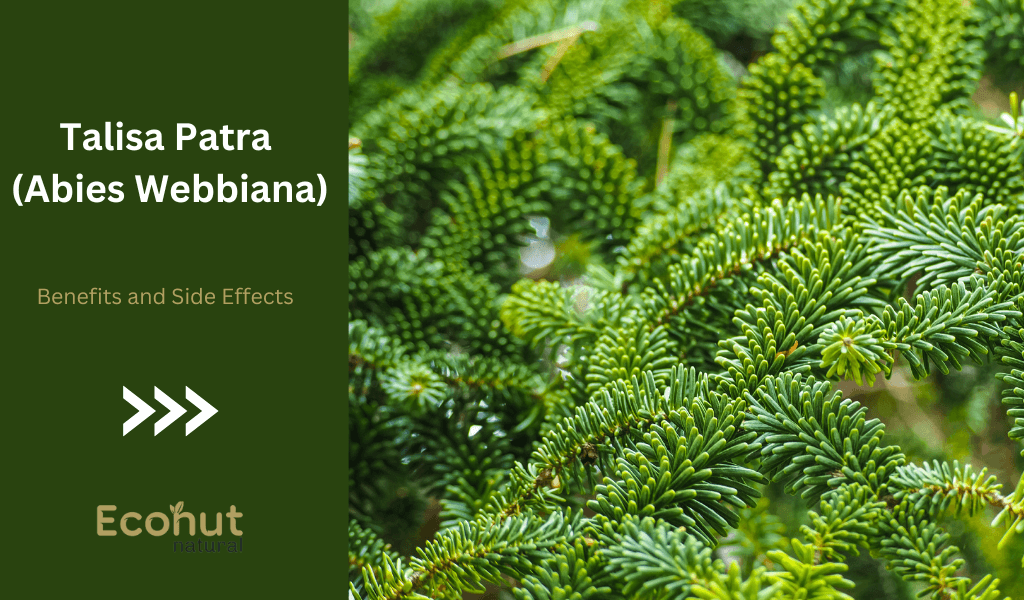Talisa Patra, scientifically known as Abies webbiana, is a species of fir tree native to the Himalayas, particularly found in regions ranging from Afghanistan to Tibet, including northern India, Bhutan, Nepal, and Pakistan. It is commonly known as the Himalayan fir or Talispatra.
Characteristics of Talisa Patra (Abies Webbiana)
Appearance:
Talisa Patra is a large evergreen coniferous tree that can grow up to 30-60 meters tall. It has a straight trunk with gray to brown bark, which becomes smooth with age. The branches are horizontally spread, and the foliage forms a conical crown.
Leaves:
The leaves are needle-like, arranged spirally on the branches. They are dark green on the upper surface and have white stomatal bands on the lower surface. The needles are flattened, about 2-3 cm long, and have a pointed tip.
Cones:
The cones of Talisa Patra are cylindrical and upright, with a length of about 10-15 cm. They start green and turn brown as they mature. Each cone contains numerous winged seeds.
Habitat:
Talisa Patra typically grows at altitudes of 1,800 to 4,000 meters above sea level in mountainous regions with well-drained soil. It prefers cool, moist climates and is often found in mixed coniferous forests alongside other species like spruce and pine.
Names of the Talisa Patra (Abies Webbiana)
Sanskrit Name: Thalispatra, Thalees, Dhaatriparni, Shukodara
English Name: Himalayan Silver Fir, Talispatra
Hindi Name: Thaleesa Patra, Talispatra
Bengali Name: Talispatra, Tallish Pala
Malayalam Name: Thaleesapathram
Kannada Name: Tales Patra, Talisapathra, Shukodara
Assamese Name: Talish
Unani Name: Talisapattar
Marathi Name: Laghu Taleespatra
Telugu Name: Taleesapatri
Nepali Name: Gobray Salla
Urdu Name: Zarnab
Tamil Name: Talispatra, Taleesapatri
Oriya Name: Talis
Gujrati Name: Tallish Patra
Bhutia Name: Dunshing
Folk Name: Badar, Morinda, Raisalla, Talispatra, Chilrow
Scientific Classification of Talisa Patra (Abies Webbiana)
| Kingdom | Plantae |
| Sub-Kingdom | Viridiplantae |
| Infra Kingdom | Streptophyta |
| Family | Pinaceae |
| Genus | Abies |
| Species | Webbiana |
| Super Divison | Embryophyta |
| Divison | Tracheophyta |
| Sub Divison | Spermatophytina |
| Class | Pinopsida |
| Subclass | Pinidai |
| Order | Pinales |
Benefites of Talisa Patra (Abies Webbiana)
Talisa Patra, also known as Abies Webbiana or Himalayan Silver Fir, is a species of fir tree found in the Himalayan region. This tree has been used in traditional medicine systems like Ayurveda for various health benefits.
Respiratory Health:
Talisa Patra is often used in Ayurvedic medicine to support respiratory health. It may help alleviate symptoms of respiratory conditions such as cough, bronchitis, asthma, and congestion.
Anti-inflammatory Properties:
It is believed that Talisa Patra possesses anti-inflammatory properties, which may help reduce inflammation in the body. This could be beneficial for conditions involving inflammation, such as arthritis.
Antimicrobial Effects:
Some research suggests that Talisa Patra may exhibit antimicrobial properties, which could help in fighting against certain bacteria, viruses, and fungi. This makes it potentially useful in treating infections.
Use in Skin Care:
Some skincare products contain extracts of Talisa Patra due to its purported skin-soothing and rejuvenating properties. It may help in treating various skin conditions and promoting healthy skin.
Digestive Health:
In Ayurveda, Talisa Patra is also used to support digestive health. It may aid in improving digestion, relieving digestive discomfort, and promoting overall gastrointestinal well-being.
Relaxation and Stress Relief:
The aroma of Talisa Patra oil is often used in aromatherapy for relaxation and stress relief. Inhaling its scent may help calm the mind, reduce stress, and promote a sense of well-being.
Antioxidant Activity:
Talisa Patra is rich in antioxidants, which are beneficial compounds that help protect the body from oxidative stress and damage caused by free radicals. Regular consumption or use of Talisa Patra may contribute to overall health and well-being.
Other Benefits of Talisa Patra (Abies Webbiana)
- It contain broncho-dialation, so helps to ease in breathing.
- This herb reduces the stress due to asthma and cough.
- The leaves of the flower help to increase appetite.
- This gives relief from spasm of involuntary muscles.
- It helps to remove toxins from the body.
- This herb gives relief in vomiting.
- It is also very useful to treat dental problems.
- This herb leaves helps to give relief from cold, sneezing, nasal congestion and watery discharge.
- The leaves of the plant contain antitussive, anti-inflammatory and mucolytic properties so helps to clear airways and dissolve thick mucus present in the lungs.
- It also reduces mucus production. So overall, helps to reduce asthma and bronchitis.
- It contain broncho-dialation, so helps to ease in breathing.
Also More: Ashoka (Saraca Asoca) Benefits and Uses
Talisa Patra (Abies Webbiana) Side Effects
While Talisa Patra may have some potential health benefits, it’s important to note that like any herbal remedy, it can also have side effects, especially if used improperly or in large doses.
Allergic reactions:
Some individuals may be allergic to components of Talisa Patra. Allergic reactions could manifest as skin rashes, itching, swelling, or respiratory symptoms like difficulty breathing.
Gastrointestinal issues:
Ingesting large amounts of Talisa Patra may cause gastrointestinal discomfort such as stomach upset, nausea, vomiting, or diarrhea.
Pregnancy and breastfeeding:
There isn’t enough reliable information about the safety of using Talisa Patra during pregnancy or breastfeeding. Pregnant and breastfeeding women should avoid using it unless directed otherwise by a healthcare professional.
Drug interactions:
Talisa Patra may interact with certain medications, such as blood thinners or medications for high blood pressure. It’s important to consult with a healthcare provider before using Talisa Patra, especially if you’re taking any prescription medications.
Liver toxicity:
Some herbal remedies, including Talisa Patra, have been associated with liver toxicity in rare cases. Symptoms of liver toxicity may include jaundice, abdominal pain, dark urine, and fatigue.
Respiratory irritation:
Inhaling or ingesting excessive amounts of Talisa Patra oil or vapors may cause respiratory irritation, coughing, or shortness of breath.
Skin irritation:
Applying Talisa Patra oil directly to the skin may cause irritation or allergic reactions in some individuals, especially those with sensitive skin.
Conclusion
Talisa Patra, scientifically known as Abies Webbiana, is a species of fir tree native to the Himalayan region. Its distinct characteristics, including needle-like leaves and conical shape, make it a prominent feature of the mountainous landscape. Renowned for its resilience to harsh conditions, Talisa Patra plays a vital ecological role in its habitat, contributing to biodiversity and ecosystem stability. Its significance extends beyond its natural environment, as it holds cultural and economic importance for local communities, symbolizing strength and endurance amidst challenging terrain.
FAQS
How is Talisa Patra typically consumed for medicinal purposes?
Talisa Patra is commonly consumed in the form of herbal teas, decoctions, powders, or extracts. It can also be used topically in the form of poultices or creams for skin-related issues.
Can Talisa Patra be used for skincare?
Yes, Talisa Patra is sometimes used topically in skincare formulations due to its purported anti-inflammatory and antimicrobial properties. It may help in managing conditions like eczema, psoriasis, and acne.
Are there any contraindications or side effects associated with Talisa Patra?
While Talisa Patra is generally safe for most people, excessive consumption or use may lead to adverse effects such as gastrointestinal upset or allergic reactions. Pregnant or breastfeeding women should consult a healthcare professional before using Talisa Patra medicinally.

